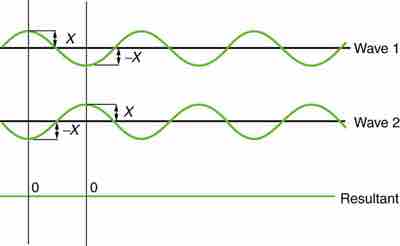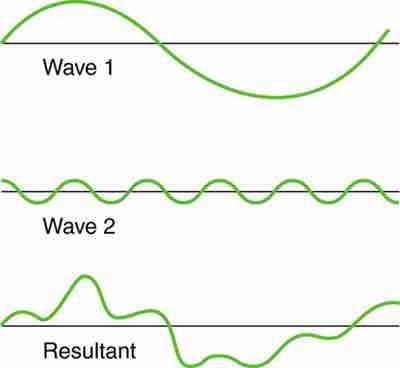Waves are most commonly described by variations in some parameter through space and time—height in a water wave, pressure in a sound wave, or the electromagnetic field in a light wave. The value of this parameter is called the amplitude of the wave; the wave itself is a function specifying the amplitude at each point.
When two or more waves arrive at the same point, they superimpose themselves onto one another. More specifically, the disturbances of waves are superimposed when they come together (a phenomenon called superposition). Each disturbance corresponds to a force, or amplitude (and the forces add). If the disturbances are along the same line, the resulting wave is a simple addition of the disturbances of the individual waves. That is, their amplitudes add.

Superposition
Superposition is when two waves add together. In this figure, the two waves add together and cancel out leaving no wave. This is destructive interference.
Superposition of waves leads to what is known as interference, which manifests in two types: constructive and destructive. Constructive interference occurs when two waves add together in superposition, creating a wave with cumulatively higher amplitude, as shown in . In destructive interference, the two waves add together but cancel out (like adding a positive and negative number). Destructive interference is shown in .
While pure constructive and pure destructive interference do occur, they require precisely aligned identical waves. The superposition of most waves produces a combination of constructive and destructive interference, and can vary from place to place and time to time. Sound from a stereo, for example, can be loud in one spot but quiet in another. Varying loudness means the sound waves add partially constructively and partially destructively at different locations. A stereo has at least two speakers creating sound waves, and waves can reflect from walls. All these waves superimpose. An example of sounds that vary over time from constructive to destructive is found in the combined whine of airplane jets heard by a stationary passenger. The combined sound can fluctuate up and down in volume as the sound from the two engines varies in time from constructive to destructive.
These examples are of waves that are similar. illustrates that when non-identical waves superimpose, the outcome is a mixture of constructive and destructive interference.

Superposition of Non-Identical Waves
Superposition of non-identical waves exhibits both constructive and destructive interference.